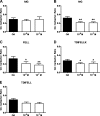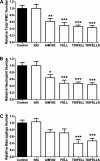Calcium-binding protein, spermatid-specific 1 is expressed in human salivary glands and contains an anti-inflammatory motif
- PMID: 25632019
- PMCID: PMC4386001
- DOI: 10.1152/ajpregu.00153.2014
Calcium-binding protein, spermatid-specific 1 is expressed in human salivary glands and contains an anti-inflammatory motif
Abstract
Salivary glands are involved in the production and exocrine and endocrine secretion of biologically active proteins, polypeptides, and hormones involved in growth and differentiation, homeostasis, and digestion. We have previously studied the prohormone submandibular rat 1 (SMR1), product of the Vcsa1 gene, which is highly expressed in the testes and salivary glands of rats, and can be cleaved to produce polypeptides with analgesic, erectile function, and anti-inflammatory activities. Humans lack the Vcsa1 gene, but homologous sequences and functions for analgesia and erectile function exist in the human genes Prol1, SMR3a, and SMR3b located on the human chromosomal region close to where Vcsa1 lies in the rat. Here we show the human protein calcium-binding protein spermatid-specific 1 (CABS1) contains a similar sequence to the anti-inflammatory sequence in rat SMR1, thus CABS1 may be another human gene with homologous function to Vcsa1. Using Western blot and PCR, we discovered that the human protein CABS1, previously thought to only be expressed in the testes, is also expressed in the salivary glands and lung, in a tissue-specific manner. Peptides derived from CABS1 were tested in an in vivo mouse model of lipopolysaccharide (LPS)-induced neutrophilia and an ex vivo rat model of antigen-induced intestinal anaphylaxis and significantly reduced both neutrophil accumulation in bronchoalveolar lavage fluid and antigen-induced ileal contractions, respectively. Thus human CABS1 has a peptide motif homologous to the anti-inflammatory peptide sequence of rat SMR1. Whether this similarity of CABS1 extends to the neuroendocrine regulation of the anti-inflammatory activity seen for SMR1 remains to be determined.
Keywords: SMR1; Vcsa1; inflammation; neutrophilia; saliva.
Copyright © 2015 the American Physiological Society.
Figures





Similar articles
-
Autonomic nervous system regulates secretion of anti-inflammatory prohormone SMR1 from rat salivary glands.Am J Physiol Cell Physiol. 2009 Mar;296(3):C514-24. doi: 10.1152/ajpcell.00214.2008. Epub 2008 Dec 24. Am J Physiol Cell Physiol. 2009. PMID: 19109528
-
Vcsa1 gene peptides for the treatment of inflammatory and allergic reactions.Recent Pat Inflamm Allergy Drug Discov. 2007 Jun;1(2):124-32. doi: 10.2174/187221307780979892. Recent Pat Inflamm Allergy Drug Discov. 2007. PMID: 19075974 Review.
-
Identification and characterization of calcium binding protein, spermatid-associated 1 (CABS1)# in selected human tissues and fluids.PLoS One. 2024 May 16;19(5):e0301855. doi: 10.1371/journal.pone.0301855. eCollection 2024. PLoS One. 2024. PMID: 38753592 Free PMC article.
-
Selective processing of submandibular rat 1 protein at dibasic cleavage sites. Salivary and bloodstream secretion products.Eur J Biochem. 1994 Feb 1;219(3):765-73. doi: 10.1111/j.1432-1033.1994.tb18556.x. Eur J Biochem. 1994. PMID: 8112327
-
The role of opiorphins (endogenous neutral endopeptidase inhibitors) in urogenital smooth muscle biology.J Sex Med. 2009 Mar;6 Suppl 3(Suppl 3):286-91. doi: 10.1111/j.1743-6109.2008.01186.x. J Sex Med. 2009. PMID: 19267851 Free PMC article. Review.
Cited by
-
Synthesis, Hydrolytic Stability and In Vivo Biological Study of Bioconjugates of the Tetrapeptides FELL Containing Pyrrole Moiety.Biomedicines. 2023 Dec 9;11(12):3265. doi: 10.3390/biomedicines11123265. Biomedicines. 2023. PMID: 38137486 Free PMC article.
-
SEQSIM: A novel bioinformatics tool for comparisons of promoter regions-a case study of calcium binding protein spermatid associated 1 (CABS1).BMC Bioinformatics. 2025 Jun 9;26(1):156. doi: 10.1186/s12859-025-06160-x. BMC Bioinformatics. 2025. PMID: 40490738 Free PMC article.
-
A method to study protein biomarkers in saliva using an automated capillary nano-immunoassay platform (Wes™).J Immunol Methods. 2020 Apr;479:112749. doi: 10.1016/j.jim.2020.112749. Epub 2020 Jan 21. J Immunol Methods. 2020. PMID: 31972214 Free PMC article.
-
Antiinflammatory peptides: current knowledge and promising prospects.Inflamm Res. 2019 Feb;68(2):125-145. doi: 10.1007/s00011-018-1208-x. Epub 2018 Dec 17. Inflamm Res. 2019. PMID: 30560372 Review.
-
Drug Administration Before or After Exposure to Low Temperatures-Does It Matter for the Therapeutic Effect?Int J Mol Sci. 2025 Apr 19;26(8):3883. doi: 10.3390/ijms26083883. Int J Mol Sci. 2025. PMID: 40332811 Free PMC article.
References
-
- Bao F, John SM, Chen Y, Mathison RD, Weaver LC. The tripeptide phenylalanine-(D) glutamate-(D) glycine modulates leukocyte infiltration and oxidative damage in rat injured spinal cord. Neuroscience 140: 1011–1022, 2006. - PubMed
-
- Barreto SG, Carati CJ, Schloithe AC, Mathison R, Davison JS, Toouli J, Saccone GT. The efficacy of combining feG and galantide in mild caerulein-induced acute pancreatitis in mice. Peptides 31: 1076–1082, 2010. - PubMed
-
- Calvel P, Kervarrec C, Lavigne R, Vallet-Erdtmann V, Guerrois M, Rolland AD, Chalmel F, Jegou B, Pineau C. CLPH, a novel casein kinase 2-phosphorylated disordered protein, is specifically associated with postmeiotic germ cells in rat spermatogenesis. J Proteome Res 8: 2953–2965, 2009. - PubMed
Publication types
MeSH terms
Substances
LinkOut - more resources
Full Text Sources
Other Literature Sources
Medical
Molecular Biology Databases

